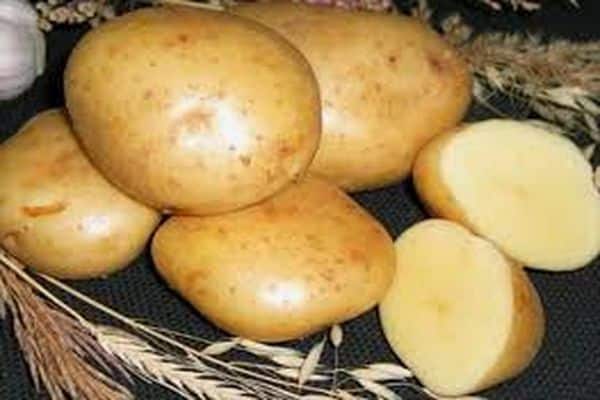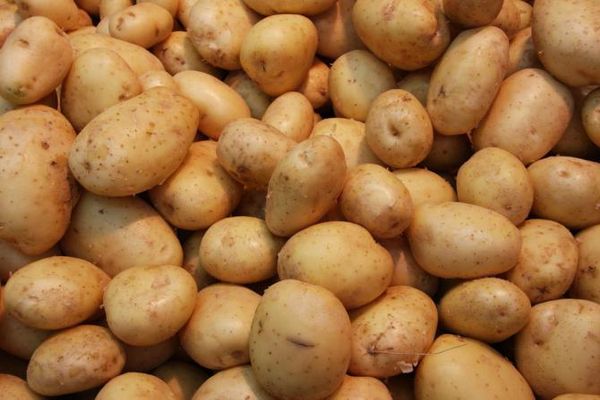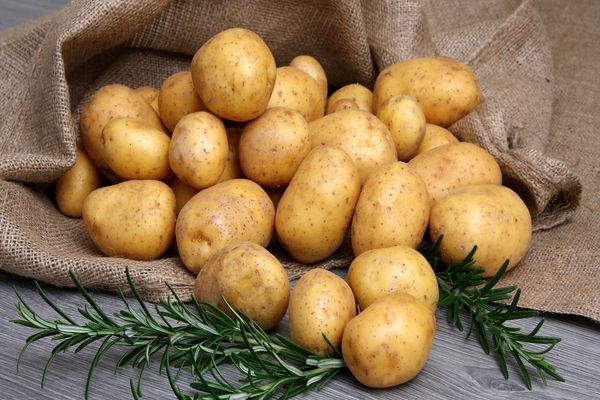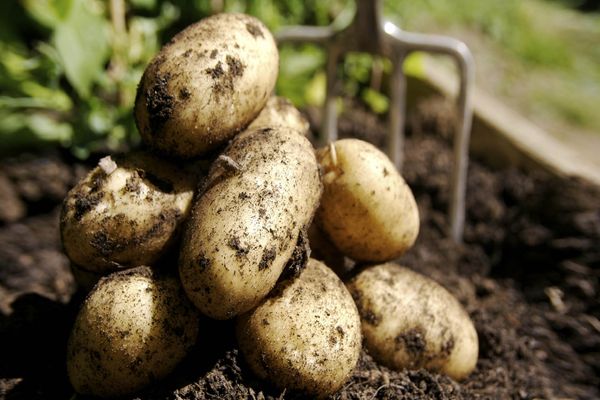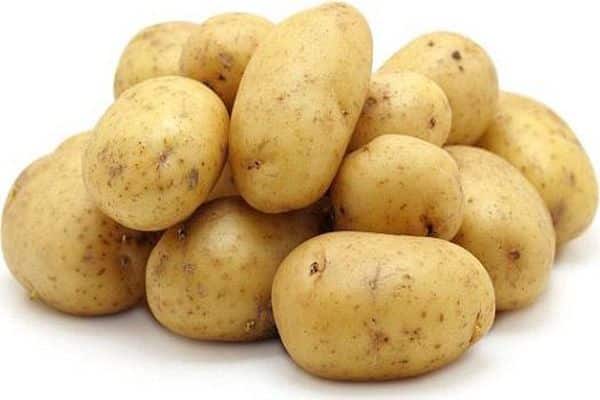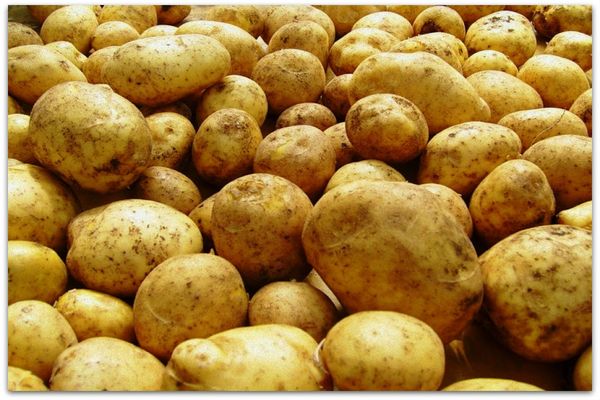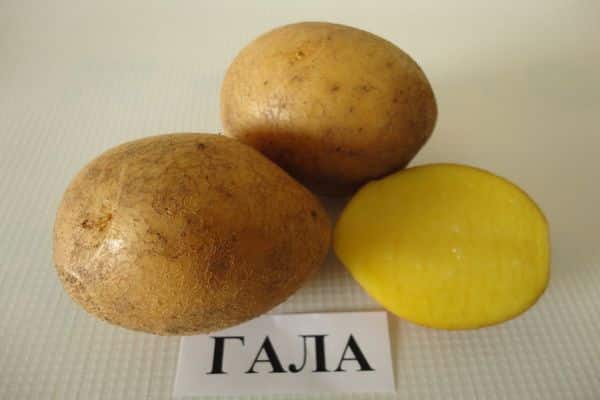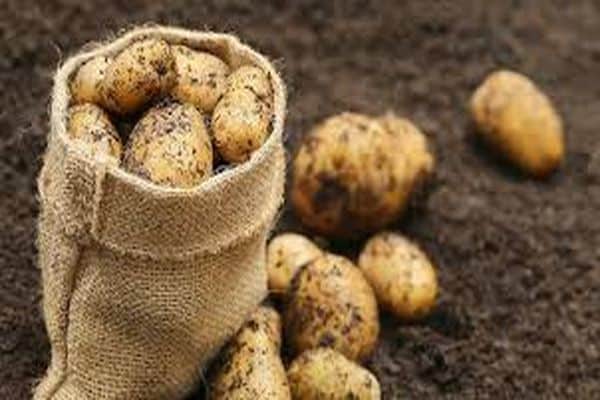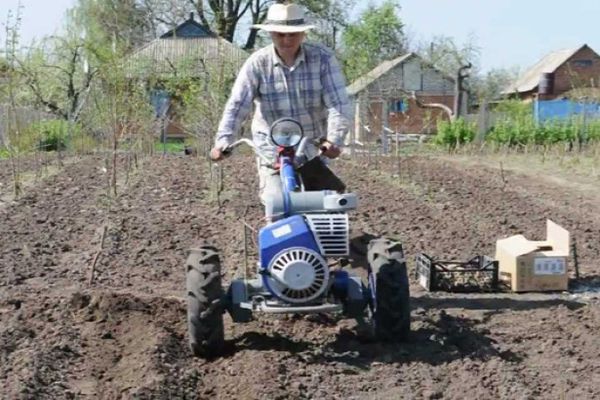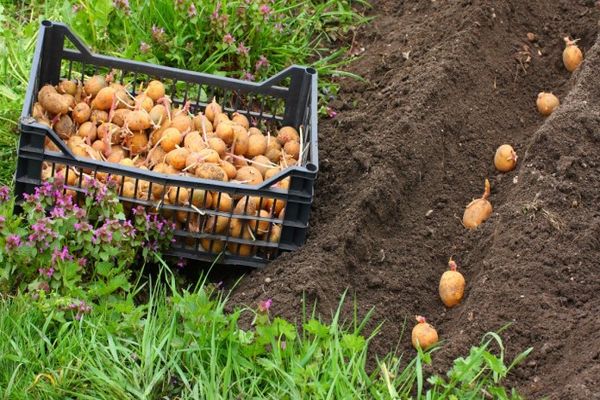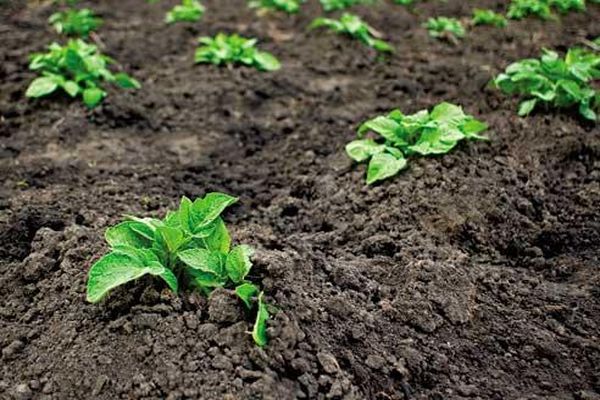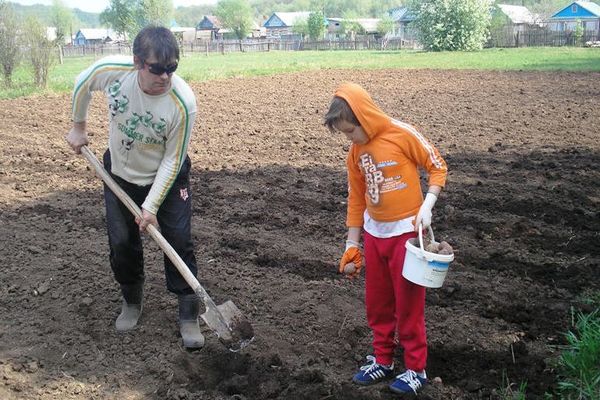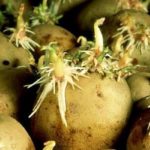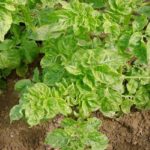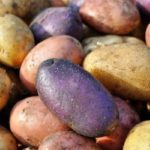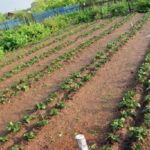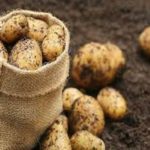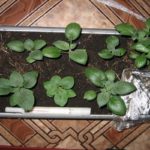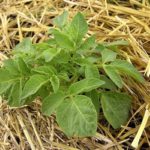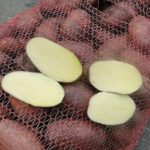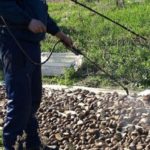In the spring, before planting a vegetable garden, you should pay attention to Gala potatoes, which have many advantages. The commercial appearance of the tubers and their excellent taste in any dish allow you to choose this variety of vegetable plant. In addition, for regions with cold climates, it is better to choose super early crops in order to collect fully ripened tubers. Potato Gala, its description will allow potato lovers not to go wrong and plant this unpretentious variety of vegetable.
- Description of the Gala variety
- Growing regions
- Advantages and disadvantages
- Features of cultivation
- Landing place
- What can you plant before and after Gala?
- Digging and fertilizers
- Soil acidity
- Holes
- Features of care
- Watering
- Weeding
- Hilling
- Potato feeding
- Pests and diseases
- Rhizoctonia as a fungus
- Late blight
- Viral diseases
- Harvest and storage
- Reviews from gardeners
Description of the Gala variety
In the description of the Gala potato variety, an important role is played by what relates to:
- productivity indicators;
- the vegetable’s requirements for growing conditions and care;
- varietal characteristics;
- resistance to weather anomalies, diseases and pests;
- ability to be stored for a long time.
Potatoes of the Gala variety have the following external description:
- Erect bushes with medium height stems.
- The foliage of the plant is average.
- The dark green leaf blades have wavy edges, which helps them adapt to the heat.
- The corolla of the inflorescence is large and white.
Tubers are formed on medium-sized bushes weighing from 100 to 120 grams. The rounded-elongated shape of the fruit with finely spaced eyes is distinguished by the excellent presentation of potato products. The top of the tubers is covered with a yellowish skin, under which lies the same colored pulp. Dining room potato variety It has a low starch content, no more than 14 percent. Therefore, it is recommended to use the product in dietary and baby food. And the yellowish color of the tubers indicates a high carotene content. When cooking, potato fruits do not become soft and do not darken.
Gala, among other mid-early potato varieties, is distinguished by its unpretentiousness and ability to be stored for a long time.
Growing regions
The Gala variety was bred by German breeders and since 2008 has been included in the State Register of mid-early potato varieties. Thanks to the high yield of potatoes, when up to 400–600 kilograms of tubers are dug up from one hundred square meters, this variety has allowed it to become a leading variety among farmers and summer residents.
Vegetables are grown in areas with unstable weather and cold climates.The vegetable is valued for its early ripening, 75 days after planting. Gala potatoes represent the best varieties of table vegetables in farmers' fields.
The plant's unpretentiousness to soils contributes to the choice of variety for growing on heavy sandy loam soils with a low humus content. The vegetable is suitable for the climate of the Volga-Vyatka, Central and Northwestern regions.
Maintains potato quality in our beds in Siberia and the Far East. 2 months after planting, you can enjoy fresh potatoes, and after 3-4 weeks - tubers completely ready for storage.
Advantages and disadvantages
The characteristics of the Gala potato variety are replete with only positive qualities of the crop:
- The harvest from a varietal vegetable can be obtained on any soil. The regions of central Russia have optimal conditions for growing potatoes of German selection.
- From one bush they dig up to 20–30 medium-sized tubers.
- Taking into account the early stages of vegetable ripening, you can vary the planting time and shift the fruit harvesting period by 1–2 weeks.
- Potato resistance to diseases is noted: bacterial cancer, scab.
- With properly organized storage, potato fruits will be stored without rot for up to 6–7 months.
- The variety has good taste. The tubers are suitable for preparing second courses, salads, and chips. It is useful to include potatoes in the menu for those who are watching their figure and want to lose extra pounds. In addition to carotene, tubers contain a lot of vitamin C and protein, which allows you to stay full without gaining weight.
Among the disadvantages of the vegetable plant is that the variety prefers high soil moisture. And if potatoes are grown in places with arid climates, then the plantings will have to be watered more often.
There is a possibility of damage to the tubers and above-ground parts of the plant by a fungus, in particular, rhizoctonia. Then the bushes begin to lag behind in development and may die, which will have a bad effect on the harvest.
Features of cultivation
Reviews from those who planted Gala potatoes and grow them in their gardens say that in order to get a harvest you need to follow the agricultural practices of the vegetable crop. For those planting varietal potatoes, it is important to determine the location for the crop in compliance with the rules of crop rotation. Proper planting and care of the crop will provide the family with potatoes for the whole winter, and will allow the farmer to sell the tubers at a great profit.
Landing place
In order for the Gala potato variety to fully demonstrate its best properties, pay attention to the choice of site for vegetable crops.
It is not recommended to leave hillsides or low-lying areas for potatoes. The area for vegetables should be level, with groundwater at a depth of 1.5 meters. It is not recommended to plant potatoes in the shade, otherwise the bushes will not reach medium height, and the tubers will be small. Only in direct sunlight does the plant develop fully with timely ripening of fruits.
High yields are obtained on light, nutritious soils if the summer is wet and cool. Poor lands are enriched with nutrients in advance. Worst of all potatoes growing on saline soils and when the air temperature is high all summer without rain.
What can you plant before and after Gala?
The rules of crop rotation and their observance are necessary so that vegetables do not require additional care, and their resistance to diseases remains reliable.
The best predecessors for Gala potatoes are cucumbers, beets and carrots.After these vegetables, you can be sure of the nutritional value of the soil.
Well nourishes the soil for planting legumes - peas, beans. It’s not for nothing that beans are planted next to potato holes. Their neighborhood is favorable.
After early ripening Gala, cabbage and cucumbers are planted. In order to plant potatoes with benefit, green manure crops are sown in advance on the plot before winter: rye, alfalfa, rapeseed, mustard. Plants will saturate the soil with nitrogen, making the soil loose and permeable to air and water.
Digging and fertilizers
Although the Gala variety adapts to any soil, it will be difficult for tubers to develop in soil that is dense and heavy in structure.
In the fall, the site is prepared by digging or plowing the soil. For heavy soil, river sand and humus are added before digging. The field is cultivated with a walk-behind tractor and a hand-held cultivator. The most reliable tool for digging is a shovel. The plowing depth should not exceed 30 centimeters.
20 grams of ammonium nitrate are added per square meter of field. To make sandy soil heavier, you can add clay.
If the work of digging the soil is carried out correctly, then in the summer hilling potatoes will pass without much effort.
Soil acidity
Like other potato varieties, Gala prefers neutral or slightly acidic soils. The acidity of the land of farmers and summer residents is determined in different ways:
- using litmus paper;
- cherry infusion;
- the predominance of plant species on the site;
- coating on the ground surface.
A greenish color of litmus paper will indicate a neutral acidity level, and a yellow color will indicate a pH value of 5.6–6.0.
By dipping a piece of soil into an infusion of bird cherry leaves, the red color of the liquid determines that the soil is acidic. A neutral composition will show a blue color, and a slightly acidic composition will show a green color.
On acidic soils, bear's ear, marianberry, peppermint, horsetail, and plantain grow well. Slightly acidic - recognized by thistle, creeping wheatgrass, coltsfoot. Rusty deposits on the ground are the result of increased soil acidity.
Constant application of dolomite flour every 5 years will maintain normal soil acidity.
Holes
Material for planting potatoes is prepared a month in advance. This includes culling tubers, leaving only healthy ones weighing 50–70 grams. It is better to cut seeds larger than 100 grams into two parts when planting, 2-3 weeks before planting. The halves are placed in the basement, spread out in a layer of 10 centimeters.
Seed potatoes are germinated 40 days in advance. To do this, the tubers are laid out in 2 or 3 layers in a bright room at a temperature of 12–15 degrees Celsius. For wet vernalization, fruits folded in boxes are sprinkled with damp soil. And kept for 10–15 days at a temperature of 14–18 degrees. The finished planting material should be slightly green with powerful shoots 1 centimeter long.
As soon as the soil in the garden warms up to 6–8 degrees, you can prepare holes and place 1–2 tubers in them.
The method of planting Gala potatoes is square-cluster according to the pattern of 70x70 centimeters. The planting depth of seed tubers is 8–10 centimeters, depending on the structure of the soil.
Features of care
Planting seeds does not end the work in the potato field. The yield of a varietal crop depends on proper care. By watering, they help the tubers reach maturity on time.
Weeding and fertilizing vegetable plantings play an important role, and hilling leads to the formation of additional underground stems and an increase in the number of tubers from one bush.
Watering
Gala potatoes are known to love moisture, so it is necessary to water the vegetable plantings, especially during dry summers. Do not let the potato beds dry out, moistening the soil abundantly. Watering begins when the bushes reach a height of 4–5 centimeters. For a plant, 3 liters of water is enough, which is poured into the middle of the bush.
It is important not to forget about moisturizing the potatoes during the flowering period and after. The amount of water increases at this time to 8–10 liters per bush. It is best to water the plants in the evening. They use different methods of watering: sprinkling, furrows, and under the root.
Weeding
For the bush to fully develop, potatoes require weeding and loosening. Since vegetable seedlings appear later than weeds, harrowing the area on a hot day will allow you to destroy small grass along with the roots.
When potato shoots appear, they walk across the field with a rake, harrowing. When the rows are closed with the closed tops of the plants, remove the weeds with your hands. During the summer, it is necessary to loosen the row spacing 3 times in two mutually perpendicular directions. The loosening depth is 6–8 centimeters.
Hilling
They increase the yield of Gala potatoes by hilling. The first time the procedure is carried out when the height of the vegetable bushes is 15–20 centimeters. They rake the ground 8–10 centimeters. It is better to carry out the second hilling before the Gala potatoes begin to bloom. It is too late to hill up flowers, as the tops of the plant bushes will close together. The second time they rake the ground 15–18 centimeters. Hill up only when the soil is damp, then additional stems underground will develop successfully. Procedures in dry weather will lead to a decrease in yield.
Potato feeding
The potato field is fed with liquid fertilizers, using up to 15 grams of ammonium nitrate and potassium salt and 30 grams of superphosphate per bucket of water. Mullein can be fed keeping the solution concentration at 1:5, and bird droppings at a concentration of 1:12.
Fertilizers are applied along with hilling. Situations arise when ovaries are weakly formed despite the powerful development of green mass. It is known why Gala potatoes do not bloom. Plantings are oversaturated with nitrogen and moisture. As soon as you add wood ash and phosphorus-potassium fertilizers into the grooves between the rows, the problem with flowering will be solved.
Pests and diseases
Gala varietal potatoes are rarely attacked by diseases and pests, but if this happens, control measures must be taken urgently:
- WITH potato scoop, causing harm in the caterpillar stage, are combated by spraying with insecticides. Prevention consists of digging up the site in the fall and burning plant waste after harvesting.
- If a mole cricket attacks, treating plants with Karbofos solution will help.
- Baits made from cake, bran, and cut potatoes poisoned with insecticides will save you from wireworms and click beetle larvae.
To free the vegetable from pest damage, when the potatoes are harvested, the tubers are treated with preparations aimed at destroying insects and their larvae.
Among fungal diseases, the Gala variety is susceptible to late blight and rhizoctonia. To avoid infection, it is necessary to use fungicidal agents. Tubers need treatment in solutions of Maxim and Prestige preparations in the fall before storing the crop in the cellar and before planting. For 10 kilograms of planting material you need 10 milliliters of Maxim. To increase plant immunity, add 2 grams of ammonium nitrate and superphosphate to the solution.
Rhizoctonia as a fungus
Rhizoctoniosis, or black scab, is classified as a dangerous fungal disease. Due to the disease, more than 30 percent of the potato crop can be lost.
The fungus affects most of the plant: the leaves and stem are covered with net necrosis, tubers with black spots or growths look diseased. Symptoms of infection include curling of the leaves at the top of the stem and stunting of the bush. The fungus develops on early potato varieties. The likelihood of infection increases when tubers are planted in cold and wet soil.
Measures to prevent rhizoctoniasis include:
- purchasing healthy seed material;
- introduction of mineral and organic complexes;
- treatment of the cellar before storing potatoes with a solution of bleach, and tubers with the drug Maxim.
Seed material often suffers from the disease. By applying measures to combat the disease, you can get rid of it completely.
Late blight
Potato rot, or late blight, is identified by brown spots on the leaves. A white coating is visible on the bottom of the plates. As soon as the leaves dry out, the disease spreads to the stems and tubers. The fruits of the vegetable turn brown, rot, becoming soft. Treat potato plantings with Arcerid three times with a break of 7–14 days. For prevention, it is advisable to apply fertilizer regularly and dry the seed potatoes thoroughly before planting.
Viral diseases
Viral infections in hot, dry weather can include curling of leaves at the bottom of potato stems. To preserve the bushes, treatments are carried out at intervals of 10 days. For spraying, take Baktofit, which is used according to the instructions. You cannot take tubers for planting from bushes infected with the virus.
Harvest and storage
Early Gala potatoes are harvested earlier than other varieties of vegetable plants. Already in August, a vegetable storage facility is prepared in advance for storing the dug up tubers.
A week before harvesting, you need to cut off the tops of the potatoes. Then a dense skin will form on the tubers, protecting the fruits from damage.
Harvesting is carried out when the tubers have reached a diameter of 4 centimeters and are covered with peel. Despite the high yield of potatoes, it is not always possible to preserve the vegetable during the winter. This happens because damaged, diseased fruits are placed in the cellar.
After drying the potato crop, it is stored in rooms with an air temperature of 2–5 degrees Celsius and a humidity of 80 percent.
Tubers require air ventilation, otherwise the crop may rot. The best place there will be wooden boxes for storing potatoes, bags.
Reviews from gardeners
In reviews of Gala potatoes you can hear a lot of positive feedback.
Tatyana, Novosibirsk:
“Despite our unpredictable climate, we grow Gala potatoes quite successfully. Our family likes medium-sized tubers. Potatoes taste amazing in any dish.”
Ivan, Irkutsk:
“My wife and I loved the Gala potato variety because it is easy to care for. We don't have time to garden. But the potatoes always grew well. In August we already dig up the tubers, dry them and store them. The harvest is harvested, you can devote time to yourself.”

